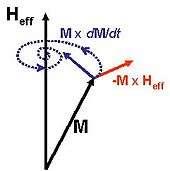Landau–Lifshitz–Gilbert equation
In physics, the Landau–Lifshitz–Gilbert equation, named for Lev Landau, Evgeny Lifshitz, and T. L. Gilbert, is a name used for a differential equation describing the precessional motion of magnetization M in a solid. It is a modification by Gilbert of the original equation of Landau and Lifshitz.
The various forms of the equation are commonly used in micromagnetics to model the effects of a magnetic field on ferromagnetic materials. In particular it can be used to model the time domain behavior of magnetic elements due to a magnetic field.[1] An additional term was added to the equation to describe the effect of spin polarized current on magnets.[2]
Landau–Lifshitz equation

In a ferromagnet, the magnetization M can vary internally but at each point its magnitude is equal to the saturation magnetization Ms. The Landau–Lifshitz–Gilbert equation predicts the rotation of the magnetization in response to torques. An earlier, but equivalent, equation (the Landau–Lifshitz equation) was introduced by Landau & Lifshitz (1935):[3][4][5]
-
(1)
where γ is the electron gyromagnetic ratio. and λ is a phenomenological damping parameter, often replaced by
where α is a dimensionless constant called the damping factor. The effective field Heff is a combination of the external magnetic field, the demagnetizing field (magnetic field due to the magnetization), and some quantum mechanical effects. To solve this equation, additional equations for the demagnetizing field must be included.
Using the methods of irreversible statistical mechanics, numerous authors have independently obtained the Landau–Lifshitz equation.[6]
Landau–Lifshitz–Gilbert equation
In 1955 Gilbert replaced the damping term in the Landau–Lifshitz (LL) equation by one that depends on the time derivative of the magnetization:
-
(2b)
This is the Landau–Lifshitz–Gilbert (LLG) equation, where η is the damping parameter, which is characteristic of the material. It can be transformed into the Landau–Lifshitz equation:[3]
-
(2a)
where
In this form of the LL equation, the precessional term γ' depends on the damping term. This better represents the behavior of real ferromagnets when the damping is large.[7]
Landau–Lifshitz–Gilbert–Slonczewski equation
In 1996 Slonczewski expanded the model to account for the spin-transfer torque, i.e. the torque induced upon the magnetization by spin-polarized current flowing through the ferromagnet. This is commonly written in terms of the unit moment defined by m = M / MS:
where is the unitless damping parameter, and are driving torques, and x is the unit vector along the polarization of the current.[8][9]
References and footnotes
- Yang, Bo. "Numerical Studies of Dynamical Micromagnetics". Retrieved 8 August 2011.
- "2.6.1 Landau-Lifshitz-Gilbert equation with Slonczewski spin-transfer torque term".
- Aharoni 1996
- Brown, Jr. 1978
- Chikazumi 1997
- T. Iwata, J. Magn. Magn. Mater. 31–34, 1013 (1983); T. Iwata, J. Magn. Magn. Mater. 59, 215 (1986); V.G. Baryakhtar, Zh. Eksp. Teor. Fiz. 87, 1501 (1984); S. Barta (unpublished, 1999); W. M. Saslow, J. Appl. Phys. 105, 07D315 (2009).
- For details of Kelly's non-resonant experiment, and of Gilbert's analysis (which led to Gilbert's modifying the damping term), see T. L. Gilbert and J. M. Kelly, "Anomalous rotational damping in ferromagnetic sheets", Conf. Magnetism and Magnetic Materials, Pittsburgh, PA, June 14–16, 1955 (New York: American Institute of Electrical Engineers, Oct. 1955, pp. 253–263). http://people.physics.tamu.edu/saslow/MMMConf55_253GilbertKelly.pdf Text references to Figures 5 and 6 should have been to Tables 1 and 2. Gilbert could not fit Kelly's experiments with fixed usual gyromagnetic ratio γ and a frequency-dependent λ=αγ, but could fit that data for a fixed Gilbert gyromagnetic ratio γG=γ/(1+α2) and a frequency-dependent α. Values of α as large as 9 were required, indicating very broad absorption, and thus a relatively low-quality sample. Modern samples, when analyzed from resonance absorption, give α's on the order of 0.05 or less.
- Slonczewski, John C. (1996). "Current-driven excitation of magnetic multilayers". Journal of Magnetism and Magnetic Materials. 159 (1): –1–L7. Bibcode:1996JMMM..159L...1S. doi:10.1016/0304-8853(96)00062-5.
- Wolf, S. A. (16 November 2001). "Spintronics: A Spin-Based Electronics Vision for the Future". Science. 294 (5546): 1488–1495. Bibcode:2001Sci...294.1488W. doi:10.1126/science.1065389. PMID 11711666.
Further reading
- Aharoni, Amikam (1996). Introduction to the Theory of Ferromagnetism. Clarendon Press. ISBN 978-0-19-851791-7.CS1 maint: ref=harv (link)
- Brown, Jr., William Fuller (1978) [Originally published in 1963]. Micromagnetics. Robert E. Krieger Publishing Co. ISBN 978-0-88275-665-3.CS1 maint: ref=harv (link)
- Chikazumi, Sōshin (1997). Physics of Ferromagnetism. Clarendon Press. ISBN 978-0-19-851776-4.CS1 maint: ref=harv (link)
- Gilbert, T.L. (1955). "A Lagrangian formulation of the gyromagnetic equation of the magnetic field". Physical Review. 100 (4): 1243. Bibcode:1955PhRv..100.1235.. doi:10.1103/PhysRev.100.1235. This is only an abstract; the full report is "Armor Research Foundation Project No. A059, Supplementary Report, May 1, 1956", but was never published. A description of the work is given in Gilbert, T. L. (2004). "A phenomenological theory of damping in ferromagnetic materials". IEEE Trans. Mag. 40 (6): 3443–3449. Bibcode:2004ITM....40.3443G. doi:10.1109/TMAG.2004.836740.
- Landau, L.D.; Lifshitz, E.M. (1935). "Theory of the dispersion of magnetic permeability in ferromagnetic bodies". Phys. Z. Sowjetunion. 8, 153.CS1 maint: ref=harv (link)
- Skrotskiĭ, G V (1984). "The Landau–Lifshitz equation revisited". Sov. Phys. Usp. 27 (12): 977–979. Bibcode:1984SvPhU..27..977S. doi:10.1070/PU1984v027n12ABEH004101.
- Guo, Boling; Ding, Shijin (2008). Landau–Lifshitz Equations. Frontiers of Research With the Chinese Academy of Sciences. World Scientific Publishing Company. ISBN 978-981-277-875-8.
- Cimrak, Ivan (2007). "A Survey on the Numerics and Computations for the Landau–Lifshitz Equation of Micromagnetism" (PDF). Archives of Computational Methods in Engineering. 15 (3): 1–37. doi:10.1007/BF03024947. Archived from the original (PDF) on 2015-07-05. Retrieved 2012-05-30.
- M, Lakshmanan (2010). "The fascinating world of the Landau–Lifshitz–Gilbert equation: an overview". Phil. Trans. R. Soc. A. 369 (1939): 1280–1300. arXiv:1101.1005. Bibcode:2011RSPTA.369.1280L. doi:10.1098/rsta.2010.0319. PMID 21320917.